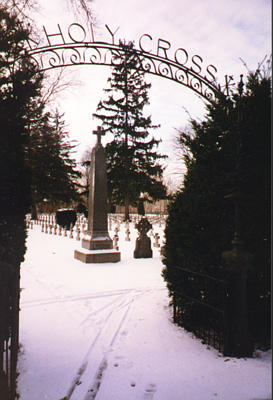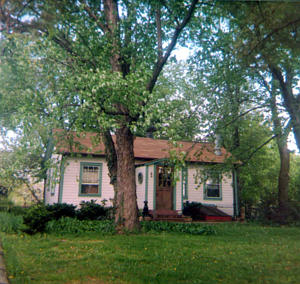
Notre Dame's Grotto / by Dorothy V. Corson

Other Masons Who Worked on the Grotto
Boleslaus Luzny and Victor Callicrate were added to the names of masons who worked on the Grotto. Family legend holds that these two men also helped build the Grotto, but there are no surviving records to confirm this. However, both men were listed as working masons in the 1896 city directory and both families were connected with the Notre Dame campus.
A local South Bend writer, Bernard Pinkowski, a friend of Boleslaus Luzny's daughter Clara, confirmed their story. He said she worked in the Notre Dame Main Building most of her adult life. She was also godmother to his child. Many times, he said, she sat at their dinner table and told of how her father helped build the Grotto. She mentioned the huge supporting stone at the base of the Grotto which her father always pointed out to her as one he had positioned there. Father Francis Luzny, a Holy Cross priest, now deceased, he said, was also related to this family. He often repeated the same story.
Another person interested in the Grotto, Leonard Preuss, was another descendent of the Luzny family and an employee on campus. He was looking for evidence that his great uncles had worked on the Notre Dame Grotto. He supplied more interesting pieces in the Grotto puzzle.
He sent obituaries and a newspaper article confirming their family stories:
The Luzny brothers were brought to South Bend (in 1881) from Germany (Polish Province) by the Oliver family to work on the Oliver home . . . Frank Luzny, his brother Boleslaus, and his cousin Roman worked on the Studebaker and Oliver mansions. They had their trade from the old country.(144)
Boleslaus' first job when he arrived here from Poland was at the University of Notre Dame where he was hired by Rev. Edward Sorin, C.S.C., founder of Notre Dame.(145)
 A 92 year old grandson of Victor Callicrate said he was told that his grandfather Victor Callicrate, and two of his sons worked on the Grotto. The Callicrate name is also associated with Notre Dame. One of Callicrate's sons, Dominic, was captain of the 1907 football team.
A 92 year old grandson of Victor Callicrate said he was told that his grandfather Victor Callicrate, and two of his sons worked on the Grotto. The Callicrate name is also associated with Notre Dame. One of Callicrate's sons, Dominic, was captain of the 1907 football team.
He then added another bit of campus lore. In his day, he said, the community cemetery for the religious was called "Boot Hill." The dictionary gives this interesting definition: "a cemetery in or near a frontier town of the old West." And the meaning of frontier? "The farthest part of a settled country, where the wilds begin." In Sorin's time it definitely applied, since the cemetery is on a hill in the frontier town of Notre Dame, Indiana. In Sorin's time, this region was known as the Old Northwest.
The remembrance of another local resident, Molly Sullivan, produced the names of two more brickmasons who worked on the Grotto. These two new names provided even more interesting details of the events unfolding in the summer of 1896 when the Grotto was being built.
Molly was a teacher of English Literature at St. Mary's Academy and Saint Mary's College. She also has her own special connection with Notre Dame's early history. She is the daughter of a Notre Dame English Professor, Richard Sullivan, now deceased, and she lives in a charming little cottage on Juniper Road less than a mile from Notre Dame. This little cottage is also steeped in Notre Dame history. Molly explained that it had once been a large chicken house on the campus, one among two, that were moved and remodeled as homes when the University began building east and north of the campus in the 1920s. A Chinese man, who owned the China Gardens, bought it from the University in 1919 and she bought it from his widow some years ago.

She said a friend of hers, who was a brickmason, often told of how his father and grandfather worked on the Grotto. This man had died, but she said his sons were brickmasons and she was sure they would be able to offer many more details she might not remember.
His son, Nick, very willingly shared his family history. He explained that being a family of brickmasons, it was common practice to pass on stories while working. He had heard the history of his grandfather and great grandfather on a number of occasions. They were skilled stonemasons who came from the old country together. They were known as church masons and steeplejacks then. Their passage was paid by Judge Gary and had to be paid off as indentured servants.
When they arrived in Gary, Indiana, they were put to work in the steel mills. They soon found themselves taken advantage of and abused, so they escaped and headed South, stopping in South Bend along the way. While in South Bend, they worked on the Tippecanoe Place, Copshaholm, the house across from it, and St. Paul's Church. They were also hired as masons to help build the Notre Dame Grotto. Their names were Nick and Lod (Ladislaf) Kowalski.
He said his father told him that he was told by his father and grandfather that two or three people died while the Grotto was being built. The Grotto had collapsed a couple times before the problem was solved and there was a problem with a large stone in the back of the niche, though he didn't recall what it was. He also remembered something about the huge boulders being unsuccessfully held in place with timbers.
His remembrance confirmed another item Father Maguire mentioned in his 1953 letter of correction:
I do not know who the builder was but he had quite a problem when he came to the roof. Many said it could not be built of such rocks; it would collapse. Finally it was decided to try it anyway and a wooden form was constructed, the roof 'keyed.' From its appearance today the work was one hundred percent perfect.
The number of masons reputed to have worked on the Grotto was growing. John Gill, the contractor, and his mason Charles McCoy, were the only ones noted in the Grotto expense ledgers. The others were Boleslaus Luzny, and possibly his brother Frank, Victor Callicrate and his sons, Nick and Lod Kowalski, and Peter Kintz and his sons. Peter Kintz, a farmer, was the only one not listed as a mason.
John Gill must have hired extra men and paid them in cash, as was customary at that time. This would account for the additional names not being on record. The sons may have worked along with their fathers as laborers. This would not be an unusual number for a project that big and heavy. Manpower would have been needed, masons as well as laborers. Generally, one laborer works with two masons. In this case, the huge boulders might have required extra hands and horses. These extra hands might have been supplied by farmers, like Kintz and his sons, upon delivering their stone.